When your business faces a challenge and needs to find a new solution, where do you start? How do you keep track of potential vendors and suppliers? Not only that, but how do you compare what each one offers? Manually conducting research online and gathering information is time consuming. In addition, this do-it-yourself approach often leaves you with an incomplete picture, because you may not be able to find the same information for each vendor. Instead, consider engaging vendors in a more collaborative, yet standardized, process using an RFI or request for information.
A request for information, often abbreviated using the acronym RFI, offers a way to share your challenge with vendors and see what kinds of solutions they suggest. As a result, your business is better equipped to make an informed decision about how to proceed.
In this blog post, we’ll offer a complete overview of a request for information. To start, we’ll provide important RFI basics including defining the meaning of RFI, its purpose and who issues them. Next, we’ll offer advice about how to write an effective RFI as well as tips and best practices. Finally, we’ll provide a helpful RFI template to get you started as well as some real-life RFI examples. This information will help you quickly create a request for information document that delivers valuable insights.
What is an RFI (request for information)?
RFI meaning
An RFI, or request for information, is a questionnaire document that asks suppliers for general information about their company and the solutions they provide. Because each prospective vendor answers the same questionnaire, comparisons are easy. The purpose of an RFI is to educate.
What is the difference between an RFI and an RFP?
If you’re familiar with the request for proposal, or RFP, you may find yourself thinking that RFPs and RFIs sound pretty similar. And, you’re right. Both of these ‘request for’ documents (as well as other RFXs) help buyers collect data from vendors and compare them. However, the goal of an RFI is simply to gather information for project research and planning when a purchase isn’t necessarily forthcoming.
On the other hand, an RFP signals that a contract is imminent and an organization is ready to buy. The goal of an RFP is to objectively compare vendors based on a number of decision factors and select the best fit for the job.
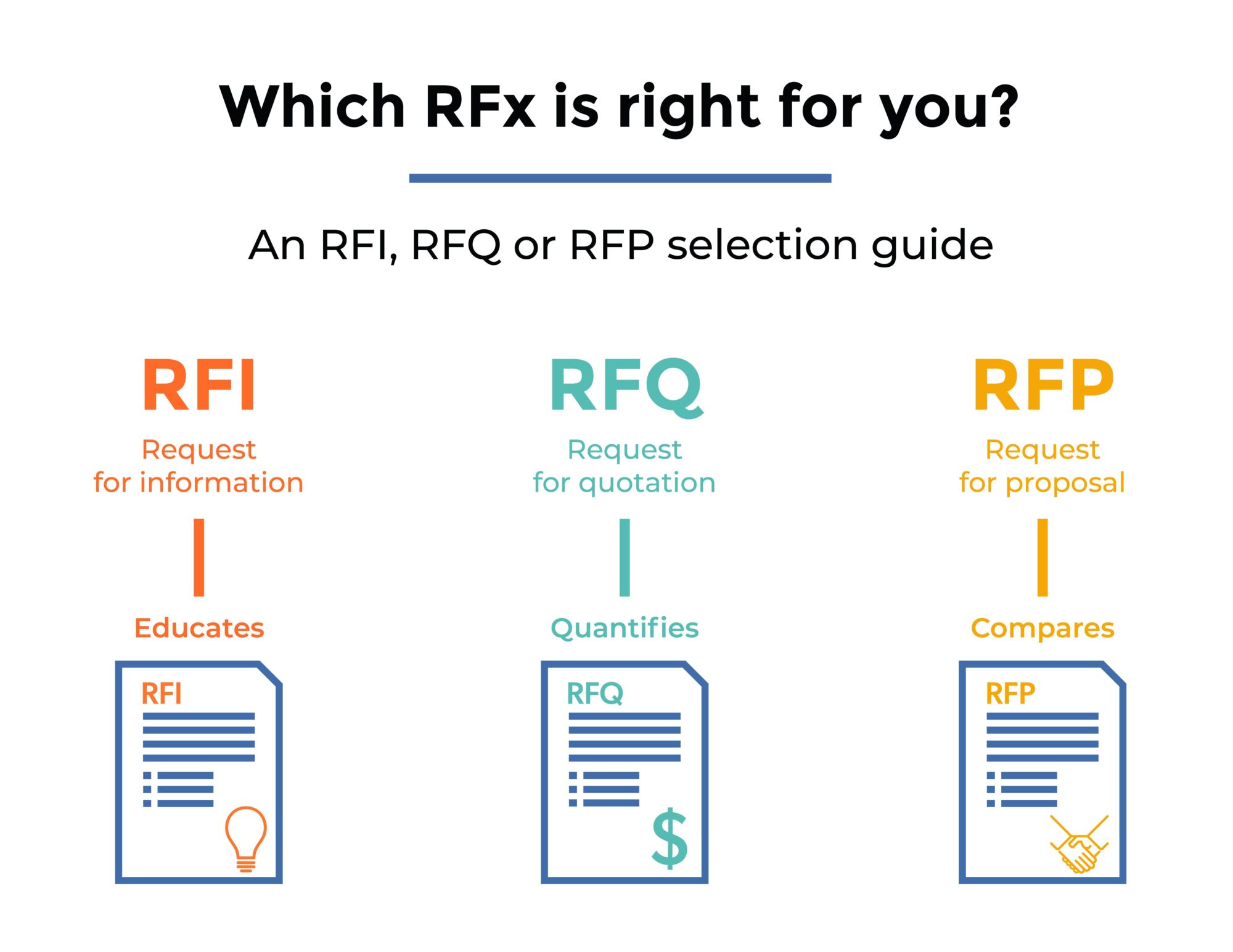
To decide which RFX is right for your project, check out this helpful infographic.
Who uses RFIs?
RFIs are a popular tool used by an organization’s procurement team. A request management survey indicates that 83 percent of procurement professionals regularly use RFIs. In fact, 25 percent of respondents estimate that they issue more than 50 RFIs per year. In addition, procurement consultants also use RFIs including those who specialize in technology, financial services, employee benefits and more.
To explore additional insights from the RFP survey, download the whitepaper: Where procurement performance and the supplier experience meet
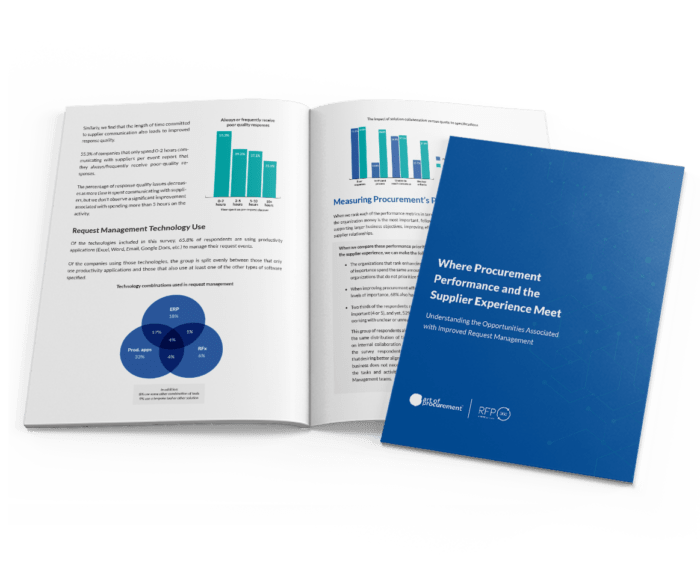
When should you issue an RFI?
Using an RFI to research and plan
In procurement, an RFI is often the first step in the purchasing process. You use this document when you have a challenge you want to overcome. However, you may not know what kind of solutions are available or even if you’re going to make a purchase. In other words, you need to understand what options you have before deciding how to move forward.
RFIs are great for research and planning. Indeed, they help you explore the market landscape, understand potential solutions and familiarize yourself with vendors. Using an RFI is like asking an expert (the vendor) how they would solve your problem. Ideally, the RFI responses provide insights that make you a more educated buyer.
Potential outcomes of a research and planning RFI
- The RFI yields a shortlist of viable vendors, an RFP is then issued to gather more information
- If the vendor comparison identifies a clear leader and the purchase in question is low cost and low risk you may decide to issue a contract
- The project is deemed out of budget, impractical or in need of further development — it may be delayed, modified or abandoned
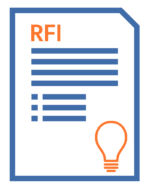
Using an RFI for recurring procurement projects
Because an RFI collects general vendor information, some businesses use RFI templates to create vendor profiles for recurring procurement projects. For example, this strategy is often used by employee benefits consultants who need to find the best possible providers for their clients. When used this way, the RFI allows consultants to easily search their records and arrive at a shortlist for their RFP quickly. In addition, because the vendor profiles store all the required general information, the RFP can be much shorter and more specific to the current needs of the business.
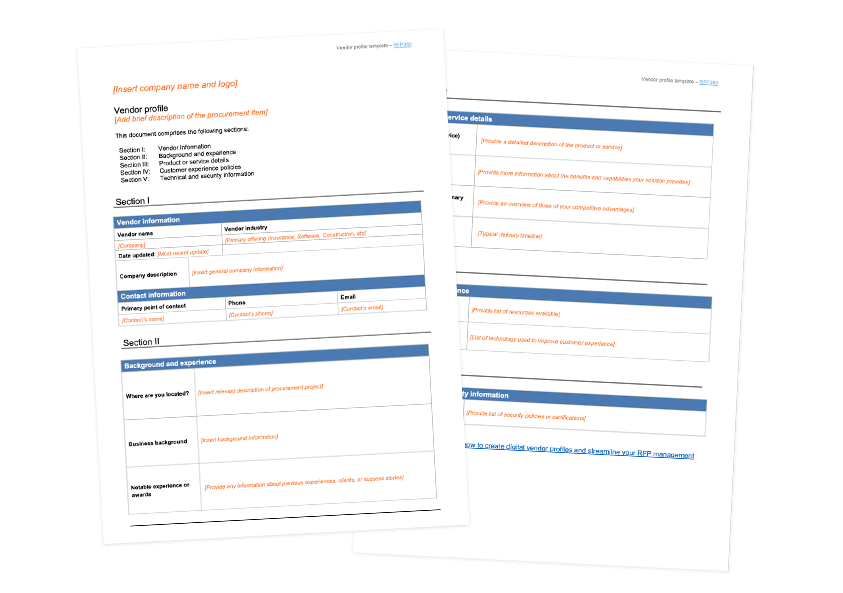
The RFI process
Now that you know what an RFI is and when you should issue one, you’re ready to start crafting your request. The RFI process comes down to three steps: creation, administration and evaluation.
1. Creation
- Define your need and create a problem statement
- Provide background about your company
- Write RFI questions to gather information
2. Administration
- Select vendors to include and send the RFI
- Answer any follow up questions
- Gather vendor responses
3. Evaluation
- Review vendor responses for viability
- Compare vendor offerings
- Consult stakeholders on findings
- Determine next steps
How to write an RFI
Sometimes, writing your RFI is the hardest part. Instead of starting from scratch, it can be helpful to start with an RFI template. No matter what kind of template you use, it’s important to always customize it to meet your needs. Unfortunately, if you don’t customize your request, vendors often see it as a red flag and may not think that the project is genuine or worth their time.
RFI tips
- Offer background info and an overview of the challenge
- Request information in a way that will be easy to compare
- Provide a clear format for vendor responses
- Ask for general information and avoid being too specific
- Be brief and respectful of the supplier’s time
RFI templates
Best all-around RFI template
This RFI template covers pretty much any situation. Whether you need information on technology and consultants, or you have a specific project you need help with, you can use this document to communicate your needs to potential providers.
It consists of the following five sections:
- Project description, goals and background — Goals and objectives
- Company information — Context about your organization
- Vendor requirements— Skills and credentials you’re looking for
- Submission instructions — How you’d like responses formatted
- Requested information — Questions exploring the vendor’s company, their solution, experience and pricing
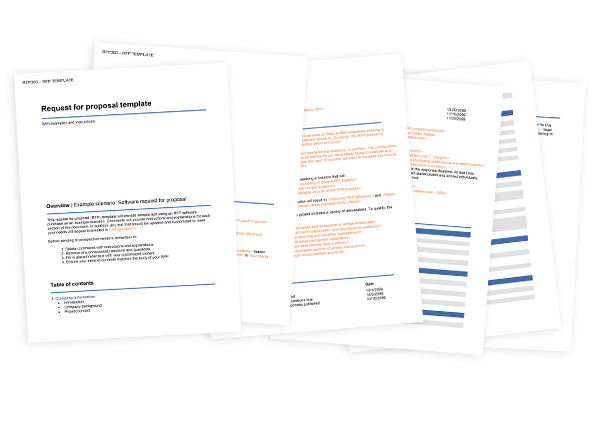
Industry-specific RFI templates
Ad agency RFI template
Demand Metric designed this RFI template to help organizations evaluate advertising agencies. What makes it so valuable is that it asks responders to provide a list of current industry-specific clients, relevant success stories and potential conflicts of interest.
When working with an ad agency, it’s important to know whether they’ve had proven success with organizations like yours. In addition, if they’re creating advertisements for your competition while soliciting your business, you’ll want to know that, too.
EHR RFI template
If you’re looking for an electronic health record (EHR) solution, this is the perfect template for you.
It covers a wide range of topics including:
- Product questions
- Customer reference questions
- Functional and technical requirements
- Operational requirements
- Transitional requirements and more
ERP RFI template
In the market for an enterprise resource planning (ERP) system? Use this RFI template to get started.
It details the criteria procurement teams should look for in an ERP, including requirements related to:
- Accounting
- Human resources
- Manufacturing management
- Inventory management
- Purchasing management
- Sales management
- Technology
Just remember, while this template is very thorough, it’s unlikely you can copy and paste the content into a document containing your logo and call it a day. You’ll need to tailor the language and requirements to meet your needs.
IT sourcing RFI template
This template was designed for banks looking to outsource IT work.
It allows banks to simply search and replace “The Bank” with their name. But, once again, we suggest tailoring the language and requirements to your situation.
RFI examples
NASA Space Shuttle Orbiter display RFI
In this RFI, NASA seeks to “make decisions regarding development of strategies for placement of Space Shuttle Orbiters and Space Shuttle Main Engines (SSMEs) for public display.” As you might expect, they have pretty stringent requirements. Use this document to get a feel for how to write a professional RFI with strict criteria.
Michigan Virtual University LMS RFI
Michigan Virtual University (MVU) issued this RFI to identify a replacement learning management system (LMS).
To ensure vendors provide responses they can easily evaluate, MVU set clear expectations and standardized responses by asking vendors to demonstrate their proficiency in 10 scenarios, stating:
“To provide the review team with comparable information, the following scenarios are to be used by each vendor to demonstrate how their product produces the required result. The interest of the team will be directed toward the ease and intuitiveness of the LMS and its interface, as well as the comprehensive set of features.”
The City of Phoenix CCMS RFI
The City of Phoenix created this RFI to identify a criminal case management system (CCMS). As early as the executive summary, the RFI contains language, shown below, encouraging vendors that don’t meet their requirements to avoid responding.
“The City seeks information on off-the-shelf solutions and on systems that require minimal customizing. The system must be as fully automated as possible, process at least 100,000 cases annually, and manage criminal cases from initiation to trial, meet all constitutional and statutory requirements, improve customer service, and enhance flexibility, efficiency, and transparency.”
Why is that important? It saves vendors from wasting time responding to an RFI that has no chance of leading to future business. In addition, it prevents the procurement team from wasting time reviewing responses from vendors that should have never replied in the first place.
A note about construction RFIs
RFIs are common in the construction industry. However, within construction the request for information serves two different purposes. When used as a part of the procurement process, a construction RFI functions identically to any other RFI. Just like a construction RFP, a business issues the RFI and a firm responds. On the other hand, an RFI form used during the course of construction seeks additional clarification and guidance about the project.
In construction, it is inevitable that questions will arise. Unfortunately, no amount of planning, specifications or blue prints can account for every real-world eventuality. That’s where the construction RFI comes in. When issues arise and the general contractor cannot proceed, they issue an RFI form to the client to seek clarification on the specific issue.
Other RFX resources
Need more templates? Interested in learning more about the other types of RFX documents? Want to know what the difference is between an RFI, RFQ and RFP?
Naturally, we’ve got you covered. Check out these helpful blog posts:
- How to write an RFQ — Templates, examples and process
- RFP meaning: A definitive guide to the request for proposal
- RFI vs RFQ vs RFP: Which should it be?
- How vendor profiles improve your sourcing process
Remember, issuing RFX documents doesn’t have to be a manual process. RFP management software allows issuers to create dynamic templates, collaborate with vendors, and leverage RFP automation to score proposals and more. Certainly RFP technology is transforming the procurement process and empowering better vendor selection.
To learn more, check out this ebook: RFP software guide: How to find an RFP solution that identifies right-fit vendors.
How RFP360 can help
RFP360 streamlines the procurement process by making it easy to create and send RFIs, RFPs, RFQs and more, as well as evaluate vendor responses.
“RFP360 helps us automate and focus on core business. Now, we can categorize, search and profile providers. We love the automated scoring. We’re shortlisting faster, and we’re being a true partner to our vendors. It’s a win-win.” – Mark Rieder, SVP of HR technologies and benefits administration at NFP.
Learn how RFP360 can streamline the procurement process at your organization. Schedule a custom demo.



